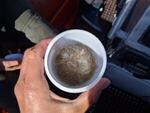Researchers analyzing the poop and prey of gray whales off the Oregon Coast estimate the mammals could be consuming millions of small bits of plastic, clothing fibers and other human debris each day that harm their health – and could hurt humans.

Gray whales, shown here feeding off the Oregon Coast, are eating an increasing amount of microparticles and microplastics that have been on the rise in the Pacific Ocean, according to recent research from the Oregon State University Marine Mammal Institute.
Courtesy of Oregon State University Geospatial Ecology of Marine Megafauna Lab
These microparticles and microplastics have been on the rise in the Pacific Ocean in the last several decades, according to the researchers from the Oregon State University Marine Mammal Institute, who published their findings in June in the journal Frontiers in Marine Science.
Leigh Torres and Susanne Brander, associate professors at Oregon State University who worked on the study, said in a news release that these microparticles threaten the health of gray whales as well as their food supply.
“That can lead to stunted growth, smaller body size, lower ability to have calves and animals not using this habitat anymore. All of those are areas of significant concern,” Torres said.
Scientists estimate that several million tons of plastic enter the Pacific Ocean each year through rivers. The plastics break up and end up in fish and other sea creatures and are later ingested by humans, something the researchers said should be a wakeup call.

Zooplankton, a primary source of food for gray whales, collected off the Oregon Coast can be seen in this cup.
Courtesy of Oregon State University Geospatial Ecology of Marine Megafauna Lab
They studied the bodies of zooplankton, a primary source of food for gray whales, in feeding zones along the Oregon Coast. They found over 400 different microparticles in the zooplankton, half of which were human-made fibers. They also analyzed samples of gray whale waste collected since 2015 from a group called the Pacific Coast Feeding Group. The group of more than 200 gray whales travels from Baja, California to British Columbia in the summer and fall to feed, choosing not to go as far as most of their peers which journey to Alaska.
The whales’ poop revealed even larger microparticles than what they could have ingested through the consumption of zooplankton alone. This led the researchers to believe that the whales consume more microparticles as they filter feed – suck up large amounts of water and essentially vacuum seafloor sediment for food.
Torres said the findings are alarming.
“It’s likely that humans are also getting a lot of microplastics from our own fish diet,” she said. “Little by little we are all getting exposed to more and more microplastics. That’s inescapable at this point across all ecosystems, including right off our coast here in Oregon.”
Torres and Brander said more needs to be done to stop microplastics from getting into marine ecosystems.
“More action needs to be taken, including here in Oregon, because this problem is not going away anytime soon,” Brander said.
This legislative session lawmakers passed two bills aimed at reducing this trash that have been signed by Gov. Tina Kotek. Senate Bill 543 will phase out polystyrene foam takeout containers, packing peanuts and coolers and ban the use of PFAS, also known as “forever chemicals” because of their longevity. Senate Bill 545 asks the Oregon Health Authority to update health codes to allow restaurants to fill a customer’s container with food.
This story was originally published by the Oregon Capital Chronicle.
Oregon Capital Chronicle is part of States Newsroom, a network of news bureaus supported by grants and a coalition of donors as a 501c(3) public charity. Oregon Capital Chronicle maintains editorial independence. Contact Editor Lynne Terry for questions: info@oregoncapitalchronicle.com. Follow Oregon Capital Chronicle on Facebook and Twitter.